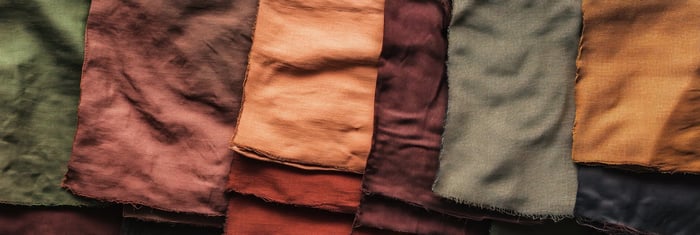 Sustainable style starts with the fabric. These eco-friendly textures are the foundation of tomorrow’s minimalist streetwear.
Sustainable style starts with the fabric. These eco-friendly textures are the foundation of tomorrow’s minimalist streetwear.Table of Contents
- Why Sustainable Fabrics Matter More Than Ever
- The Environmental Impact of What You Wear
- Dyeing & Finishing: The Chemistry That Matters
- Fast Fashion’s True Cost
- Gen Z’s Role: From Call‑Outs to Call‑Ins
- Longevity Is a Sustainability Superpower
- Care & Repair Rituals That Cut Impact
- How to Read a Product Page (Mini Checklist)
- Supply Chain Resilience: Why Local Matters
- Cost vs. Value: Price Per Wear
- Myth‑Busting: What Sustainable Fabric Isn’t
- Overview of Sustainable Innovations
- 1) Regenerative Organic Cotton
- 2) Hemp 2.0
- 3) Tencel™ Luxe & Next‑Gen Lyocell
- 4) Recycled Cotton (Pre‑Consumer)
- 5) Piñatex® (Pineapple Leaf Fiber)
- 6) Recycled Polyester from Ocean‑Bound Plastic
- 7) Banana Fiber (Abacá) Textiles
- 8) Wool from Regenerative Farms
- 9) Mycelium Leather (Mushroom‑Based)
- 10) Algae‑Based Textiles
- Material Matchups: Choosing the Right Tool for the Job
- Sourcing Signals to Trust vs. Red Flags
- Streetwear Styling Notes for Key Fabrics
- Innovation Scorecard: How We Evaluate Materials
- What We’re Testing in 2025 (R&D Notes)
- Where to Buy Sustainable Fabrics (Gen Z Guide to Conscious Sourcing)
- Conclusion: From Fabric to Future
- FAQs
Introduction — Sustainable Fabric Isn’t Just a Trend, It’s the Future
The fashion world is having a reset moment. For decades, fast fashion pumped out disposable clothes made from fossil‑fuel fibers, flooding landfills and waterways with waste. Gen Z looked at the receipts and said: do better. That’s where sustainable fabric enters—not as a buzzword, but as a redesign of how we grow, spin, dye, sew, and care for what we wear.
At EcoBear Wear, our lane is premium minimalist streetwear—clean lines, quiet details, and built‑to‑last construction. We choose sustainable fabric materials that deliver elevated drape, breathable comfort, and low impact across their lifecycle. Think regenerative cotton, next‑gen lyocell, and plant‑based leathers that look sharp without the planet tax.
In this guide, you’ll get two things: first, why sustainable textiles matter for the planet—and for your wallet. Second, a streetwear‑centric breakdown of the innovations shaping 2025. Use it as your fabric filter: when labels feel vague, you’ll know what to ask and which materials deserve your money.
Why Sustainable Fabrics Matter More Than Ever
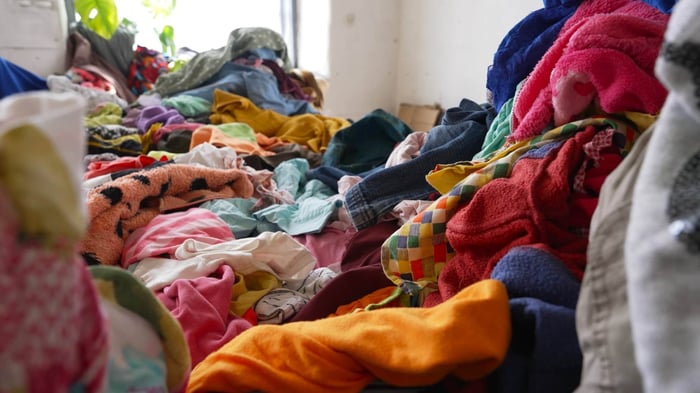 Synthetic waste doesn’t just disappear—it lingers for decades. Choosing better fabrics means less in the landfill.
Synthetic waste doesn’t just disappear—it lingers for decades. Choosing better fabrics means less in the landfill.The Environmental Impact of What You Wear
Fabric choice sets the tone for a garment’s footprint. Polyester and nylon—made from petrochemicals—dominate fast fashion and shed microfibers with every wash. Those particles travel through rivers to oceans, where they’re eaten by marine life and work their way up the food chain. By contrast, sustainable fabrics for clothing like organic cotton, hemp, and Tencel™ lyocell can cut water use, avoid toxic pesticides, and reduce emissions via closed‑loop processing and renewable inputs.
Impact wins to know:
- Organic cotton can reduce blue‑water consumption while avoiding hazardous pesticides.
- Hemp grows fast, enriches soil, and thrives with minimal irrigation.
- Lyocell uses a closed‑loop system that recovers and reuses the solvent.
- Wool and other natural proteins biodegrade under the right conditions, reducing long‑term waste.
Dyeing & Finishing: The Chemistry That Matters
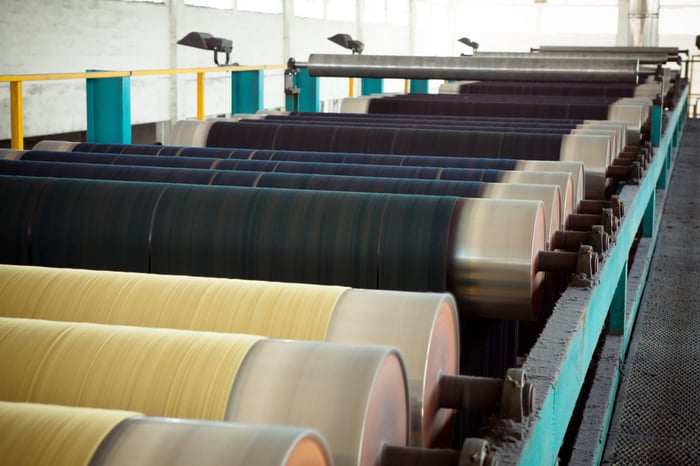 From thread to trend—see how fabrics get their color. Choosing low-impact dyes makes fashion more sustainable.
From thread to trend—see how fabrics get their color. Choosing low-impact dyes makes fashion more sustainable.Most of a fabric’s water and chemical load comes from dyeing and finishing—not just fiber production. Conventional dye houses may use salts, heavy‑metal dyes, and large energy inputs to fix color. Better mills are adopting lower‑impact dye stuffs, bio‑based auxiliaries, and closed‑loop water systems that recycle and treat effluent. Finishes are getting smarter, too: mechanical softening replaces harsh chemical softeners; enzyme washes replace stone washing; and PFC‑free options deliver water repellency without forever‑chemicals. Translation: color that lasts, handfeel that’s premium, and a footprint you can stand behind.
Fast Fashion’s True Cost
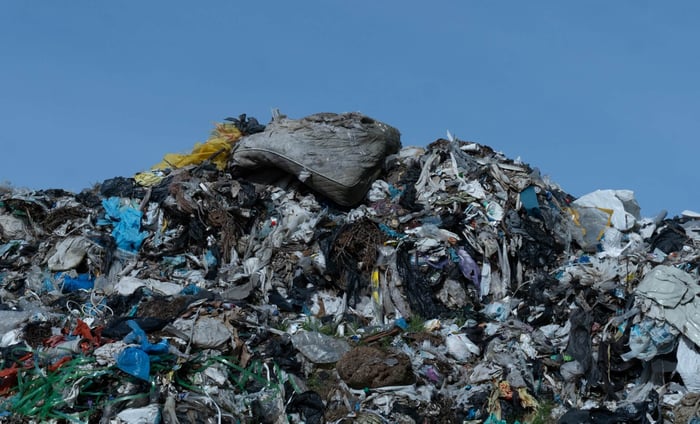 Every garment tossed has a cost. Let’s keep clothes out of landfills and in rotation.
Every garment tossed has a cost. Let’s keep clothes out of landfills and in rotation.Fast fashion optimizes for speed and price, not longevity. Garments lose shape, pill quickly, and get trashed after a handful of wears. That drives overproduction and mountains of textile waste. Choosing higher‑quality sustainable textiles flips the model: you buy fewer pieces, wear them longer, and repair instead of replace. The result is less extraction, less transport, and fewer trips to the landfill.
Gen Z’s Role: From Call‑Outs to Call‑Ins
Gen Z changed the conversation from hype to accountability. We read fiber content labels, check brand transparency pages, and expect traceability. When claims feel fuzzy—“eco‑friendly,” “green”—we push for proof. That pressure is catalyzing real change: better certifications, more recycled content verification, and clearer end‑of‑life plans. The takeaway: your purchase decisions are a lever.
Longevity Is a Sustainability Superpower
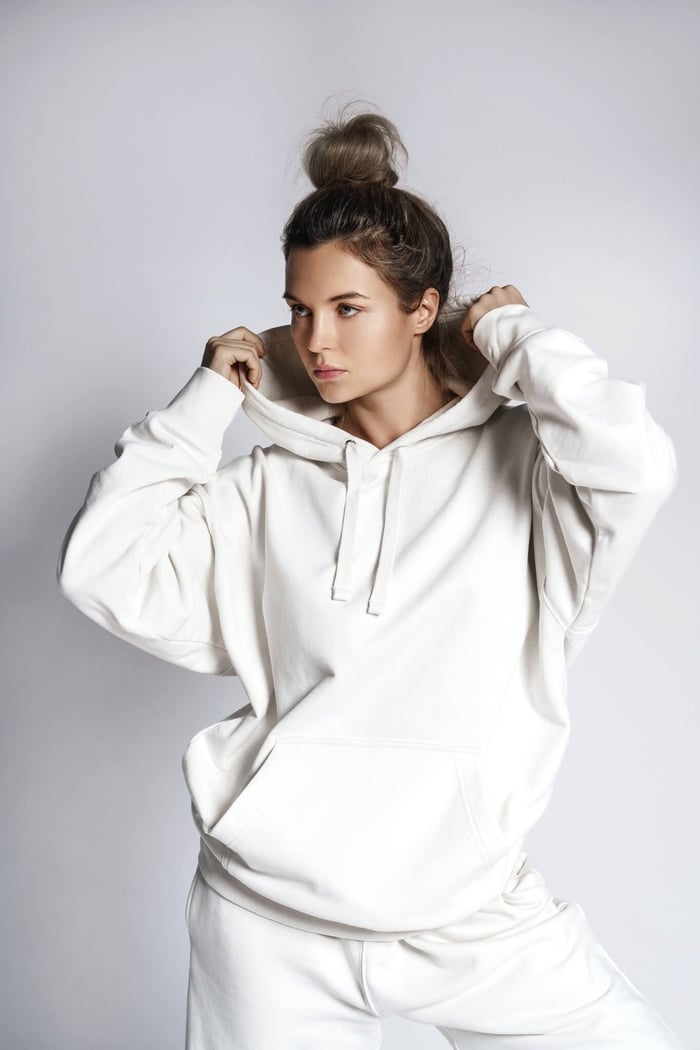 Sustainability never looked this good. Premium comfort, timeless style.
Sustainability never looked this good. Premium comfort, timeless style.A garment you love and wear for years beats any ‘sustainable’ piece that falls apart in months. Material quality, yarn twist, knit density, and finishes matter. At EcoBear Wear, we test for pilling, shrinkage, and colorfastness so your hoodie looks day‑one fresh after wash twenty. Durability stretches the wear‑per‑use equation and lowers the cost per wear—financially and environmentally.
Care & Repair Rituals That Cut Impact
 A few stitches can save a favorite fit. Repair, reuse, repeat.
A few stitches can save a favorite fit. Repair, reuse, repeat.Care is part of sustainability. Wash on cold to slash energy use and reduce color loss. Turn garments inside out, use a gentle detergent, and skip fabric softeners that can coat fibers. Line dry when you can; heat degrades elastics and shortens life span. Keep a tiny repair kit—needle, thread, spare buttons, a fabric shaver for pills—and your pieces will look premium for longer. Pro move: air out tees after wear instead of auto‑washing; it saves water and preserves handfeel.
How to Read a Product Page (Mini Checklist)
- Fiber clarity: Say ‘Tencel™ lyocell 60% / organic cotton 40%,’ not just ‘eco blend.’
- Impact notes: Call out water/chemistry savings and dye/finish choices.
- Mill or region transparency: Spinning/knitting/dyeing locations show real traceability.
- Care guidance: Brands who care about longevity teach you how to wash and repair.
- End‑of‑life: Monomaterial construction, take‑back, or repair services are green flags.
- Greenwashing watch: Vibes without numbers is a red flag; ask questions.
Supply Chain Resilience: Why Local Matters
Sustainability is also about resilience. Regionalizing steps like knitting, dyeing, and cut‑and‑sew reduces transport emissions and shortens lead times, which means fewer overproduction bets and less dead stock. When a brand can name its mill partners and explain why they’re chosen—quality, water treatment, worker safety—that’s a strong signal the impact story is real, not retrofitted by marketing.
Cost vs. Value: Price Per Wear
Sustainable doesn’t always mean cheap—but it can mean better value. A $120 hoodie worn 120 times costs $1 per wear; a $40 hoodie that bags out after ten wears costs $4 per wear and likely ends up in the bin. When you evaluate materials and construction, think in price‑per‑wear and longevity—not sticker shock.
Myth‑Busting: What Sustainable Fabric Isn’t
- It’s not automatically beige and boring—minimalism can be luxe.
- It’s not scratchy or stiff—next‑gen blends are soft from day one.
- It’s not fragile—durability is part of the brief.
- It’s not perfection—better choices, consistently applied, beat all‑or‑nothing thinking.
Overview of Sustainable Innovations
These are the ten innovations we’re tracking in 2025. We’re evaluating them for streetwear‑ready performance, everyday comfort, credible impact, and circular design potential. Each entry includes what it is, why it matters, how EcoBear Wear would use it, and one real‑world verification tip for shoppers.
1) Regenerative Organic Cotton
What it is: Cotton grown with regenerative practices—crop rotation, cover cropping, composting—that restore soil and sequester carbon.
Why it matters: Softer handfeel, lower chemical load, healthier farms, and climate‑positive potential.
EcoBear use case: Everyday tees and heavyweight fleece with a refined drape that holds its structure.
Verify this: Look for clear farm‑level info and responsible ginning/spinning partners; beware vague ‘better cotton’ claims with no details.
2) Hemp 2.0
What it is: Next‑gen hemp yarns that are softer and finer, often blended with organic cotton or lyocell for elevated handfeel.
Why it matters: Low water needs, natural pest resistance, and exceptional durability.
EcoBear use case: Structured hoodies and overshirts that break in beautifully.
Verify this: Check GSM and blend percentages; higher hemp content should still feel soft, not scratchy.
3) Tencel™ Luxe & Next‑Gen Lyocell
What it is: Lyocell fibers produced in closed‑loop systems; Luxe variants bring a subtle sheen and enhanced strength.
Why it matters: Efficient solvent recovery, moisture management, and premium drape.
EcoBear use case: Tees and midlayers that stay fresh on long wear days.
Verify this: Look for explicit lyocell (not vague ‘rayon’) and mill transparency on closed‑loop processing.
4) Recycled Cotton (Pre‑Consumer)
What it is: Factory offcuts and yarn waste respun into new yarns instead of landfilled.
Why it matters: Cuts waste and demand for virgin cotton while adding subtle texture that looks luxe up close.
EcoBear use case: Fleece and jersey with depth—perfect for monochrome sets.
Verify this: Brands should cite the recycling percentage and whether fibers were blended for strength.
5) Piñatex® (Pineapple Leaf Fiber)
What it is: A plant‑based leather alternative made from agricultural waste (pineapple leaves).
Why it matters: Diverts waste, supports farm communities, and avoids animal hides and petroleum‑based PU.
EcoBear use case: Trims, patches, and small accessories that elevate without compromise.
Verify this: Look for durability testing details; not all plant‑based leathers perform the same.
6) Recycled Polyester from Ocean‑Bound Plastic
What it is: Fibers spun from collected bottles, fishing nets, and packaging headed for waterways.
Why it matters: Reduces reliance on virgin petroleum and intercepts waste; strong and quick‑drying for performance.
EcoBear use case: Weather‑resistant outerwear and lining fabrics where durability is critical.
Verify this: Ask for recycled content percentages and microfibre‑mitigation guidance (wash bags, filters).
7) Banana Fiber (Abacá) Textiles
What it is: Fibers from banana plant stems; lightweight, breathable, and surprisingly strong.
Why it matters: Renewable and harvested without felling the plant; blends create unique textures for clean designs.
EcoBear use case: Warm‑weather shirts and elevated tees with a subtle slub.
Verify this: Confirm blend partners (cotton/lyocell) and fabric weight to ensure comfort.
8) Wool from Regenerative Farms
What it is: Wool produced with rotational grazing and land stewardship that restores ecosystems.
Why it matters: Naturally thermoregulating and odor‑resistant; biodegradable at end‑of‑life.
EcoBear use case: Transitional layers and beanies designed for multi‑season wear.
Verify this: Look for humane animal care statements and low‑impact scouring/dyeing notes.
9) Mycelium Leather (Mushroom‑Based)
What it is: Non‑animal leather grown from mycelium mats in controlled environments.
Why it matters: Weeks to grow, minimal water and land, customizable aesthetics from suede‑like to sleek.
EcoBear use case: Limited‑edition trims, labels, and small goods that keep the look minimal and premium.
Verify this: Seek clarity on binders/finishes; some versions still use synthetics for strength.
10) Algae‑Based Textiles
What it is: Bio‑based fibers and foams derived from algae, sometimes combined with celluloses for strength.
Why it matters: Potentially carbon‑negative inputs and inherent antimicrobial properties.
EcoBear use case: Lightweight tees and liners that stay fresh longer.
Verify this: Ask for care guidance—some bio‑based foams/films are heat‑sensitive.
Material Matchups: Choosing the Right Tool for the Job
- Hemp vs. Regenerative Cotton: Pick hemp for maximum durability and structure; choose regenerative cotton when softness and familiar handfeel lead.
- Lyocell vs. Recycled Polyester: Go lyocell for breathability and drape in daily wear; choose recycled polyester for weather‑resistant shells.
- Regenerative Wool vs. Recycled Fleece: Reach for wool when odor control and temperature regulation matter; grab recycled fleece for lightweight warmth and easy care.
- Banana Fiber vs. Linen: Abacá brings similar breathability with a smoother hand; linen offers crisp texture but creases more.
- Mycelium Leather vs. Piñatex®: Mycelium can mimic a wider range of finishes; Piñatex® shines in trims and structured small goods.
Sourcing Signals to Trust vs. Red Flags
Trust signals: clear fiber breakdowns; mill or regional transparency; responsible dye/finish notes; recycled or regenerative percentages; care and repair guidance.
Red flags: vague ‘eco fabric’ with no specifics; mixed fiber blends with no rationale; no care guidance; buzzwords with zero data. If you can’t find answers, ask—good brands reply.
Streetwear Styling Notes for Key Fabrics
Regenerative cotton: heavy GSM tees with crisp collars pair well with tailored joggers.
Hemp blends: structured hoodies that hold shape—minimal branding, maximum texture.
Lyocell: drapey tees and midlayers for clean silhouettes that move.
Recycled cotton fleece: monochrome sets with depth; subtle tonal embroidery.
Regenerative wool: rib beanies and overshirts that transition across seasons.
Innovation Scorecard: How We Evaluate Materials
We rate each material across five pillars before it enters our lineup:
1) Impact: Water, chemistry, land‑use, and verified recycled/regenerative inputs.
2) Longevity: Pilling resistance, seam strength, and colorfastness after 20+ washes.
3) Handfeel: Drape, softness, breathability, and how it breaks in.
4) Circularity: Monomaterial options, recyclability, take‑back compatibility.
5) Aesthetic Fit: Does it support clean, minimalist silhouettes without heavy embellishment?
What We’re Testing in 2025 (R&D Notes)
We’re prototyping hemp‑lyocell fleece that balances structure with buttery handfeel; exploring algae‑infused liners for odor control; and validating PFC‑free repellents on recycled polyester shells. The bar is simple: if it doesn’t feel premium and wear beautifully, it doesn’t ship.
Bottom line: sustainable fabric isn’t a single silver bullet—it’s a toolkit. Mix the right fibers, engineer the right knits, and care for them well, and you get pieces that feel premium on day one and still look sharp on day 400.
EcoBear Wear is building with these sustainable textiles now. Join the VIP pre‑launch list to see the first drops and get early access to limited runs.
Where to Buy Sustainable Fabrics (Gen Z Guide to Conscious Sourcing)
When you’re on the hunt for the perfect sustainable fabric, it’s not just about finding something that looks good—it’s about knowing exactly where it comes from, what it’s made of, and how it impacts the planet. For EcoBear Wear, we treat sourcing like curating a playlist: every pick sets the tone for our brand story, and we don’t add a track unless it’s a banger.
The good news? 2025 is a golden age for sustainable fabric materials, with brands, suppliers, and marketplaces making it easier than ever to get fabrics that align with your values and your aesthetic. Whether you’re a fashion student DIY’ing your first hoodie, a small-batch designer, or just fabric-obsessed, these are the spots worth bookmarking.
1. Harts Fabric — Organic & Eco-Friendly Apparel Fabrics
Harts Fabric has been a staple for sewists and small brands who want high-quality, low-impact materials. Their organic cottons, hemp blends, and Tencel™ options check all the boxes: certified, breathable, and ready for both streetwear and loungewear.
Why It’s Gen Z Approved: Wide range of bold colors (rare for organic lines), fast shipping, and transparent sourcing notes for each product.
2. Sustainable Jungle’s Curated Fabric List
This isn’t a fabric store—it’s a goldmine of research. Sustainable Jungle breaks down sustainable fabrics for clothing by fiber type, impact, and use case. You’ll find everything from cork leather to pineapple fiber (Piñatex).
Pro Tip: Use their list to cross-check what you see on supplier sites so you know you’re not falling for greenwashing.
3. Core Fabric Store — Ethical Fabric Heaven
Core Fabric Store offers a carefully selected range of eco-certified fabrics. Think organic cotton twills, bamboo jerseys, and recycled polyester fleeces—perfect for elevated streetwear staples.
EcoBear POV: We love their swatch ordering system. For premium minimalist pieces, testing texture and drape before committing is key.
4. ECOALF — Innovation Meets Transparency
ECOALF’s site isn’t just about fabrics—it’s about storytelling. Their sustainable textiles come from post-consumer waste like plastic bottles and fishing nets, spun into performance fabrics with an urban edge.
Why Shop Here: If you’re into tech-meets-fashion, their offerings show what’s possible when innovation leads the design process.
5. Honey Be Good — Artisanal & Small-Batch
For one-of-a-kind looks, Honey Be Good stocks handwoven and small-batch organic fabrics. The textures are rich, the patterns unique, and the quality unmatched.
Gen Z Mood: Perfect for statement pieces in capsule wardrobes—each yard feels personal.
6. BBC Earth’s Recommended Materials
BBC Earth has covered six fabric materials that could help save the planet, from banana fibers to lab-grown spider silk. While they’re not a retailer, their spotlight articles point you toward emerging suppliers.
Pro Tip: Follow these leads to get ahead of mainstream trends—ideal for building an “I knew about it first” collection.
7. Good On You — Brand Ratings & Fabric Insight
Good On You rates fashion brands for sustainability, but their guides on fabrics are just as useful. They break down environmental impact, water use, and biodegradability for each fiber type.
EcoBear POV: We cross-reference their ratings when picking mills—it’s like a background check for textiles.
8. Reddit’s r/SustainableFashion Community
Want real talk? Reddit’s r/SustainableFashion is where you’ll find unfiltered recommendations on where to get sustainable fabrics for clothing at every budget level.
Why It Matters: Peer reviews cut through the marketing fluff—if a supplier’s quality drops, you’ll hear about it fast.
9. Stonemountain & Daughter Fabrics
Known for their diverse range of eco-friendly fabrics, this store is a favorite for both fashion students and seasoned designers. Organic denim, hemp canvas, and deadstock fabrics are their strong suit.
Pro Tip: Deadstock is a sustainable win—using what’s already produced keeps textiles out of landfills.
10. Local Fabric Markets & Artisan Co-ops
Don’t underestimate your local scene. Farmers’ markets, craft fairs, and artisan co-ops often have vendors selling hand-dyed organic cottons, upcycled fabrics, or reclaimed vintage textiles.
Gen Z Edge: It’s not just sustainable—it’s exclusive. No one else will have that exact yardage.
How to Choose Your Sustainable Fabric Sources
When you’re buying sustainable fabric materials, here’s how to make sure you’re walking the talk:
- Check Certifications: Look for GOTS (Global Organic Textile Standard), OEKO-TEX®, or Fair Trade.
- Read the Fiber Content: “Eco” can be vague—make sure the percentages match your expectations.
- Ask About Dyes: Low-impact or natural dyes are better for you and the planet.
- Start Small: Order swatches or minimal yardage to test quality before scaling.
Conclusion: From Fabric to Future
The sustainable textiles market is no longer niche—it’s the future of fashion. By knowing where to buy sustainable fabrics, you’re not just making better clothes; you’re shaping an industry that values transparency, ethics, and quality.
At EcoBear Wear, every hoodie, tee, and jogger starts with fabric that meets our three non-negotiables: premium feel, minimal environmental impact, and durability that outlasts fast-fashion trends. It’s not the easiest path—but it’s the only one that makes sense.
FAQs
What makes a fabric “sustainable”?
A sustainable fabric is produced with methods and materials that minimize environmental impact throughout its lifecycle—from fiber cultivation and processing to dyeing, finishing, and end-of-life. Examples include regenerative organic cotton, hemp, lyocell, and recycled fibers that use fewer resources, avoid toxic chemicals, and support circular design.
Why should I choose sustainable fabrics over regular ones?
Sustainable fabrics reduce water waste, chemical pollution, and greenhouse gas emissions while offering better quality and longevity. Choosing them means fewer garments ending up in landfills and more value per wear—saving you money in the long run.Sustainable fabrics reduce water waste, chemical pollution, and greenhouse gas emissions while offering better quality and longevity. Choosing them means fewer garments ending up in landfills and more value per wear—saving you money in the long run.
Are sustainable fabrics more expensive?
They can cost more upfront due to better-quality inputs, ethical labor, and responsible production. However, their durability means a lower cost per wear compared to cheaper, fast-fashion fabrics that degrade quickly.
How can I tell if a brand is truly using sustainable fabrics?
Look for clear fiber breakdowns, certifications like GOTS or OEKO-TEX®, transparency about mills or regions, and impact notes about water and chemical savings. Be cautious of vague “eco-friendly” claims without data or specifics.
Where can I buy sustainable fabrics for my own projects?
Great sources include Harts Fabric, Core Fabric Store, Stonemountain & Daughter Fabrics, and artisan co-ops. Also check curated lists from Sustainable Jungle, Good On You, and BBC Earth for verified suppliers.
